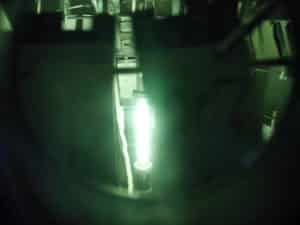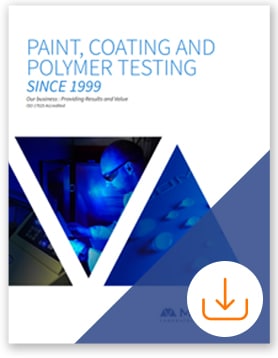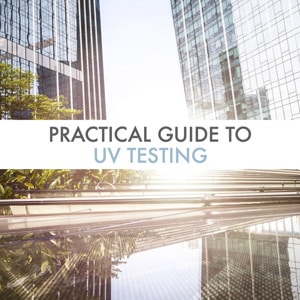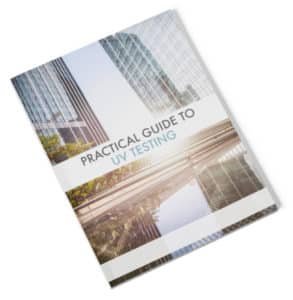ASTM G155
Standard Method for Using Xenon Arc Lamp Apparatus for Exposure of Non-Metallic Materials
ASTM G155 is an essential method for evaluating the resistance of materials to the most rigorous environmental and solar exposure conditions. Using a xenon light source, this standard rapidly simulates the UV effects of the sun, such as light intensity, humidity, and heat that can lead to a reduction in the aesthetic qualities of non-metallic materials.
Micom Laboratories is proud to offer testing services in accordance with ASTM G155, which is titled ‘Practice for Operating Xenon Arc Light Apparatus for Exposure of Non-Metallic Materials.’ This method is the cornerstone of many standards related to accelerated aging by solar ultraviolet radiation. ASTM G155 and other standards derived from it cover a wide range of products and applications. To view a product category list, refer to our dedicated Xenon Arc Testing section. ASTM G155 tests allow us to faithfully replicate the effects of accelerated aging due to UV radiation, whether outdoors or through a window.
Uses and Benefits of ASTM G155

ASTM G155 is used to age a wide range of products in various industries, including those for the automotive industry, surface coatings, pharmaceutical light stability testing, printing inks, roofing, rubber, adhesives, automotive, textiles, geotextiles, and more.
This method exposes samples to repeated cycles of exposure to a filtered xenon arc, simulating different conditions depending on the filters used. Depending on the conditions you wish to simulate, humidity, and in some cases, a rain cycle simulating watering will also be combined with the exposure, all within a controlled environment.
The Practical Benefits
Using ASTM G155 offers many practical advantages. This method allows us to predict how materials and products will react to prolonged exposure to sunlight, which is vital for maintaining their aesthetics, durability, and real-life performances. Furthermore, it facilitates the establishment of robust specifications and performance standards for a variety of industries, enhancing consumer confidence and satisfaction in products subjected to these in-depth tests.
Experimental Parameters and Implementation of ASTM G155
To perform a relevant accelerated weathering test that is right for your application the following test parameters need to be defined carefully:
- Overall exposure duration (hours) (used to simulate indoor/outdoor conditions)
-
Lamp filters
-
The lamp irradiance level
-
The type and duration of moisture exposure
-
The timing of the light and moisture exposure
-
The temperature of light exposure
-
The temperature of moisture exposure
-
The timing of a light/dark cycle.
There are predefined cycles in Table X3.1 of ASTM G155 that can be used when doing xenon arc testing. Please feel free to contact us if you need guidance in deciding which test cycle or test conditions to use for your specific needs. Our experts will be happy to assist you in obtaining the best accelerated weathering test possible.
We take care of testing from start to finish
So you can focus on what you do best
We get it, we're the only ones in the room excited by testing.
That's why we've fine-tuned every step of the testing process to provide you with
a fast and reliable service at a cost that will keep you coming back.
This is the Micom promise.
We take care of testing from start to finish
So you can focus on what you do best
We get it, we're the only ones in the room excited by testing.
That's why we've fine-tuned every step of the testing process to provide you with
a fast and reliable service at a cost that will keep you coming back.
This is the Micom promise.
We take care of testing from start to finish
So you can focus on what you do best
We get it, we're the only ones in the room excited by testing.
That's why we've fine-tuned every step of the testing process to provide you with
a fast and reliable service at a cost that will keep you coming back.
This is the Micom promise.
Customized Services for Optimal Results with ASTM G155
At Micom, we understand that every project is unique. Our team of experts is ready to guide you in choosing parameters, performing tests, and helping you understand the results. We offer personalized support at every step to ensure you get the best possible results.
Exploration of Related Methods – ASTM G154
As an alternative to xenon arc exposure, we invite you to consider ASTM G154, which uses a different light source, fluorescent lamps. For more information about alternative methods, you can refer to the following page: Accelerated Aging.
How to choose between ASTM G154 and ASTM G155 UV testing?
The decision tree will help you understand how to choose between UV tests ASTM G154 and ASTM G155.
Explore Our Full Range of Testing services
ASTM G155 is referenced in several ASTM test methods. These include ASTM D2565, ASTM D4459 and ISO 4892, which also offer xenon arc testing.
After exposure to ASTM G155, various measurements can be taken to quantify the impact of aging. Please refer to ASTM testing and coating testing for more information on these follow-up approaches.
In addition to ASTM G154 and G155 tests, explore the range of our testing services for coatings, paints, and polymers. Download our brochure below for more details.
Take Action Today to Improve Your Product reliability
If you’re ready to harness the benefits of ASTM G155 to improve the reliability of your products, please feel free to contact our team today. We’re here to discuss your specific needs, provide detailed information about our services, and help you plan the next steps toward more robust, high-performance products.
Practical UV Testing Guide
Sunlight exposure can have harmful impacts on carbon-based
materials such as coatings, polymers, textiles, and many others.
Learn more about our in-laboratory UV testing process in this guide.




 A free eBook to help you better safeguard your products from UV damage.
A free eBook to help you better safeguard your products from UV damage.